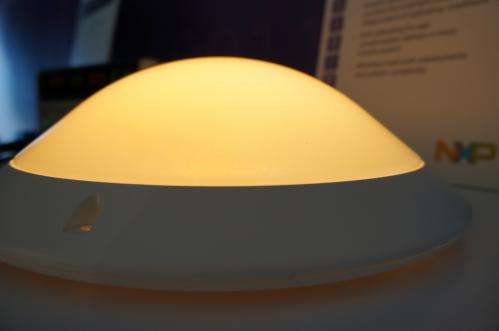'Sensorless sensing' technology enables accurate correction of temperature effects on LED performance

When comparing LEDs to incandescent light bulbs, there is a noticeable difference in light quality: LED lamps when dimmed are perceived to be "colder" than incandescents. At CES 2013 this week, NXP Semiconductors is demonstrating a groundbreaking solution that allows LED lamps to closely mimic the traditional incandescent light bulb, to produce a warmer, cozier white light as they are dimmed. Featuring "sensorless sensing" technology, developed and patented by NXP, this solution also has the advantage of driving down LED system costs by eliminating external temperature sensors, reducing the size of the heat sinks required for LED system cooling, and significantly improving reliability.
NXP's tunable dimmable white LED demo can be viewed in its "Future Innovations" area of its booth (CP8), and in this demo video:
With incandescent light bulbs, the light color becomes warmer and more atmospheric as they are dimmed and become less bright. In contrast, LED lamps today are typically unable to match the colors experienced by the users of conventional light bulbs, over the entire dimming range.
To enable the LED to mimic an incandescent when dimming, the NXP solution has integrated three key features into the driving circuitry:
- Combining white and amber LEDs as a cost-effective way to create colors most pleasing to the human eye, following the black-body radiation curve
- Implementing logarithmic correction for eye sensitivity using an analytical model that allows the desired color points to be achieved while dimming
- Using sensorless sensing to measure LED junction temperature directly, enabling accurate, efficient real-time temperature correction, which is critical for reliable control of LED performance in any conditions
"Our research team originally set out to answer the question: What would it take to inspire consumers to finally embrace LED lighting with the same affection they have for incandescents? With sensorless sensing technology, we're demonstrating a new way to achieve the warm quality of light we associate with incandescent light bulbs, using dimmable LED lamps. By reducing the number of components required, sensorless sensing also helps to reduce total system costs, removing another significant barrier to widespread LED adoption," said Michael Bruno, senior director of business development, Advanced Technologies and Future Innovations, NXP Semiconductors. "The elegance of this approach significantly improves LED reliability and lifetimes, and there is tremendous potential for sensorless sensing in other areas, such as automotive SSL and commercial LED applications."
For further information, please contact your NXP account manager, or visit NXP this week at Central Plaza 8, CES 2013.
Provided by NXP
















